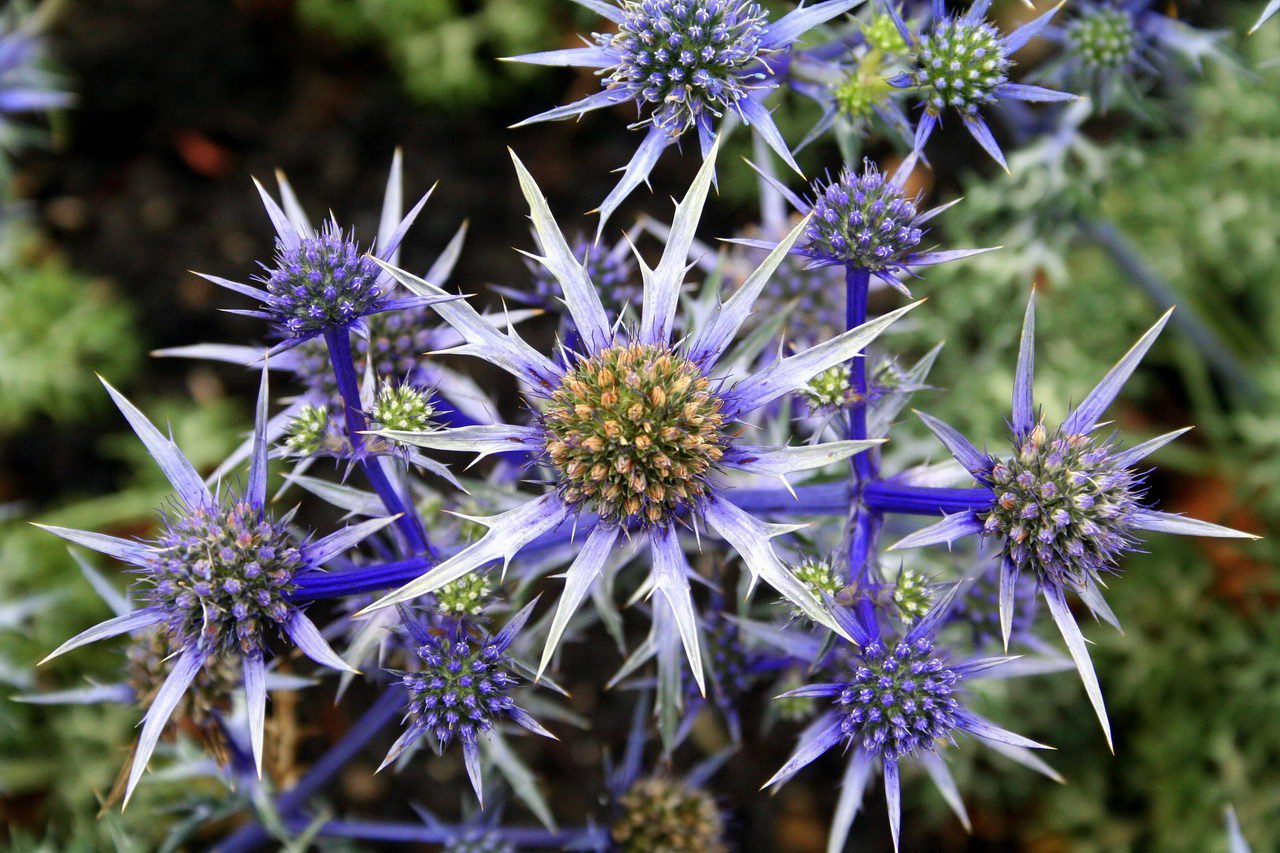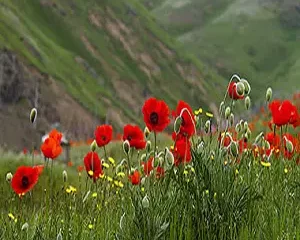Mediterranean sea holly specifications
- Scientific name : Eryngium bourgatii
- Common Name : Sea holly, blue sea holly, star thistle
- Family : Apiaceae
- Genus : Eryngium
- Order : Apiales
- Plant Type : Herbaceous, perennial
- Mature Size : 2–3 ft. tall, 1–2 ft. wide
- Sun Exposure : Full
- Soil Type : Sandy, well-drained
- Bloom Time : Summer, fall
- Flower Color : Blue, purple
- Native : Mediterranean, Europe and Asia
Sea holly plants are low-maintenance perennials with basal clumps of dark green leaves that produce taller flower stems with striking purple-blue flowers that look like small glowing thistles from midsummer until fall. Native to Europe, sea holly flowers have green or blue cones and a distinctive bract collar in silver, white, green, or bluish-purple. The colors have a painted-on, metallic sheen that changes in the sunlight, and their stems can be green or silvery blue, depending on the variety. mediterranean sea holly
Sea holly plants, once fairly specialized, are now available in many garden centers and stores in limited varieties. Spring is the best time to plant mature plants—sea holly will grow quickly, and semi-mature nursery plants will flower in their first season. Sow seeds in late summer or fall, and they’ll germinate in spring. Once established, these are long-lived perennials.
read more : Everything about blue eringo plant : How to Plant & care for them

Sea Holly Care
Sea holly plants are easy to care for, as long as you provide the proper soil and sun conditions. You’ll want to plant sea holly in dry to medium sandy soil in a location that boasts full sun. Once planted, it will require little tending. Flowering for most varieties starts in midsummer and will continue well into the fall.
Sea hollies have deep tap roots which makes them difficult to move, so be sure to place the plant somewhere it can stay for the long term. It’s a great option for all those spots in the garden where the hose doesn’t quite reach, or for more difficult spots, like a strip of grass between the sidewalk and the street. It has a good tolerance for salty soil, so it does well in coastal gardens.
Tall sea holly varieties often need some support, so planting them behind sturdier species, like coneflower, will help keep them standing. mediterranean sea holly
-
Light
A full day of sun ( at least eight hours ) will give you the strongest sea holly plants and the most blooms. While the plants can handle partial shade, the reduction in light may lead to weaker stems, which may make it necessary to stake the plants to keep them upright.
-
Soil
The best planting medium for sea holly plants is well-drained, sandy, poor to moderately fertile soil. Soil that is too rich can make sea hollies sprawl. Good drainage is a must, so amend compact soil with compost. Additionally, sea holly is not particular about its soil pH—anything around the neutral range is sufficient ( pH 6.1–7.8 ). However, the plants do need good drainage or they will be susceptible to root rot and can die off.
-
Water
Thanks to the long taproot, sea holly plants are very drought tolerant once established and won’t need additional water unless subjected to a prolonged drought at the peak of summer. That being said, excess surface moisture can cause the flower’s crown to rot, so sea holly plants should be somewhat segregated from other plants that require more water. If and when watering is necessary for the plant, aim the water source at the base of the plant to reduce the risk of built-up moisture.
-
Temperature and Humidity
As long as it’s planted within its proper hardiness range ( zones 5 to 9 ), sea holly does not have any additional temperature or humidity requirements. It will do better in the cooler days of spring and fall but will not die off in warmer weather. mediterranean sea holly
-
Fertilizer
Sea holly plants are not heavy feeders. In fact, too much fertilizer will make the plants sprawl. Plant these where you have poor, moderately fertile soil in your garden.
read more : Everything about teasels plant : How to Plant & care for them
Types of Sea Holly
New introductions of sea holly come out regularly and claim the shelf space of older types. While they’re all lovely, some do grow better in certain conditions, so check to see which are successful in your area.
Here are some favorites :
- ‘ Jade Frost ‘ is a variety that boasts variegated foliage, with pink margins and veins.
- ‘ Blue Glitter ‘ is a bountiful variety with dozens of blooms per plant and gray-blue foliage.
- ‘ Sapphire Blue ‘ is a classic favorite with striking blue flowers and leaves.
- ‘ Tiny Jackpot ‘ is a petite variety that grows to just 14 inches tall and looks good at the front of a border.
Iran dried Sea holly plant
Due to its unique beauty, dried sea holly have many usages in interior decoration design. Dried sea holly is one of Iran’s export goods and has provided a great opportunity for Iranian traders to bring a lot of currency to the country by exporting dried sea holly.
read more : Drying natural flowers | Introducing 8 wonderful ways to dry flowers
Pruning
Sea holly will bloom longer if you deadhead the spent flowers. At the end of the growing season, prune the plants off near ground level. But the spent flowers also look wonderful long into winter, so you always have the option to leave the fall flowers on the stems. mediterranean sea holly
Propagating Sea Holly
Sea holly’s taproot can make it a bit difficult to propagate, but it’s possible to do it via root cuttings :
- Carefully dig up the plants in late summer ( taproot and all ), then cut away healthy sections of roots ( but never cut away more than one-third of the plant’s total root mass )
- Replant the parent clump immediately, then plant the individual root sections in a mixture of compost and vermiculite in a small pot, making sure the cut end ( crown side ) of the root segment is facing up. The root segment should be entirely buried, but the cut tip should be just barely under the surface.
- Overwinter the pots in a sheltered location. In spring, the root segments should begin to generate new roots, which you will see poking out of the bottom of the pot.
- When a network of roots is established and green shoots are emerging above the soil line, you can transplant your new sea holly plant into the garden.
read more : Everything about scabiosa flower : How to Plant & care for them
How to Grow Sea Holly From Seed
Most sea holly varieties can be started from seed, though the process is a little complicated — they will do best if stratified ( chilled to stimulate the growth cycle ) first. The easiest method of planting is to directly sow the seeds in the fall, then patiently wait to see what sprouts up in the spring.
If you want to get a head start, you can start sea holly seeds indoors. After collecting seeds in the fall, chill them for about four weeks in the refrigerator, then plant them in small pots filled with a sandy potting mix. The seedlings can be planted outdoors the following spring when all danger of frost has passed. As with many perennials, these seedlings may take most of the first growing season to establish good root systems — in subsequent years, you can expect them to flower at the expected time.
Potting and Repotting Sea Holly
It’s rare that sea holly is grown as a potted plant on decks or patios, since it does not like the rich fertility of most potting mixes. It does much better in dry, sandy, even barren soils. That said, it is certainly possible to grow sea holly in a well-draining container filled with a sandy potting mix, such as a 50-50 mixture of standard potting soil and succulent / cactus mix. Be diligent not to overwater potted plants, and make sure they get as much direct sunlight as possible. mediterranean sea holly
Potted sea holly plants will need to be moved to a sheltered location for the winter, such as tucked in beside a garden wall or placed in a cold frame. But don’t try to move them indoors as houseplants, as sea holly needs a winter dormancy period brought on by cool conditions.
read more : Everything about echinops : How to Plant & care for them
Overwintering
Provide some protection against winter cold to allow the rosettes to overwinter successfully, or the plant will use all of its energy making new foliage in the spring. Lay evergreen branches over the plants or mulch with pine needles. Withhold water in fall, as it does not care for damp winter soil. After flowering is complete, cut the flower stalks and foliage back to just above ground level. You can also leave the flowers for winter interest.
Common Pests & Plant Diseases
In dry soils, sea holly is generally free of nearly all pests and diseases. In damp soil, it can be susceptible to fungal leaf spot diseases and root rot. Powdery mildew can also be a problem; base watering and good air circulation will minimize mildew infection. Moist conditions may encourage aphids, slugs, and snails to feed on the foliage.
Fungicides can help control serious leaf spot disease. Aphids can usually be easily controlled with horticultural oil ( or simply ignored, since the damage is rarely serious ). Slugs and snails can be removed by hand or controlled with baits. mediterranean sea holly
How to Get Sea Holly to Bloom
When grown in properly dry soil and sunny conditions, there’s rarely any problem getting sea holly to bloom in its typical summer-to-fall flowering period. Failure to bloom can be the result of too little sun, but it can also be the result of soil that is too rich and fertile.
read more : Everything about yarrow flower : How to Plant & care for them
Common Problems With Sea Holly
Sea holly is largely free of complaints, but you may find that the plants become overly leggy and sprawling if it is planted in soil that is too fertile and rich. Thus, it’s best to reserve this plant for those parts of the garden with dry, sandy soil where other plants won’t grow. Such sprawling may also occur if sea holly doesn’t get enough sun, or if you overwater it. mediterranean sea holly
Notice : This article translated by google form Persian language. If you have any question or need more information please contact us or add a comment at the bottom of this page.


0 Comments